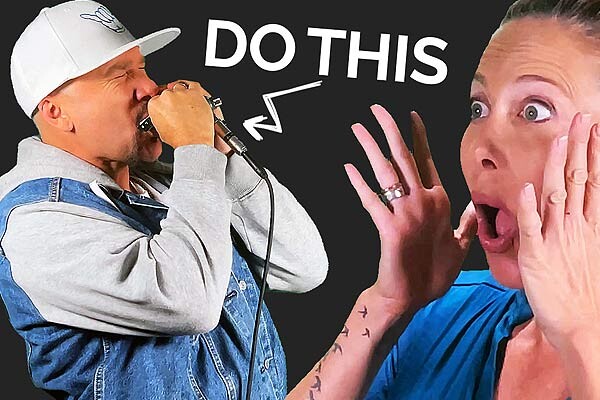If you structure your harmonica solos like you’re telling a story, you can captivate an audience. In this video I show you how to do this by analyzing one of my own harmonica solos.
(I didn’t even realize that my drummer and my lovely wife are grinning like Cheshire cats until I saw this video. ![]() )
)
Here are the 3 big take-homes for delivering a knock-out solo…
1. Restraint!
This solo is about 2 minutes long. If I came out of the gate with the fast train that I start doing 1:30 into it, where could I possibly build from there?
Instead, I start by using SPACE . I play 4 notes, and then leave almost 2 WHOLE BARS OF REST. Of course, it helps when the drummer and guitarist’s groove is as solid as a ROCK like these guys’ are! ![]()
I always say a solo should tell a story, and that all great stories have:
![]() a beginning - the setting
a beginning - the setting
![]() a middle - the climax(es)
a middle - the climax(es)
![]() an end - the resolution
an end - the resolution
How do you make the beginning of your solo feel like the beginning of a story?
Make a short statement, and then leave SPACE.
This draws in the listener, and gives you a place to build from. I leave space after the next two phrases as well. By the time I’m playing my 4th phrase I’m playing A LOT of notes, but then I leave space again .
This business of leaving space requires conscious restraint, but it pays off cos:
The beauty is in the silence between the notes.
2. Emotion!
When it’s time to play I’m not thinking about beats and bars, or scales, or riffs…
Sure, I know I’m playing in A Mixolydian using a D harmonica in 2nd position blah, blah, blah. But I just close my eyes and put my heart into every note. It’s all about emotion .
To build some excitement, I use repetition . In a span of 13 seconds, the little -4 -4 -5 5 -4 figure is played a total of SEVEN times ! Wow, that’s a lot of repetition. Wow, that’s a lot of repetition. Wow, that’s a lot… you get the point ![]() This helps hook the riff into the audiences’ ears.
This helps hook the riff into the audiences’ ears.
My favorite way to reach a climax is with the -45 trill . I’m all about giving the people what they want. ![]() You can’t hear the crowd in the video, but believe me, they cheered at the -45 trill (as they always do!)
You can’t hear the crowd in the video, but believe me, they cheered at the -45 trill (as they always do!)
Another way I like to climax is holding and bending the -6 . But also, just before I go there, notice that I nod the bass player to enter. So while the -6 is great, it’s probably actually the entrance of the bass player that really makes the moment feel so good ! Secret tricks of the trade. ![]()
The final climax is the 10 to 10” blow bend ending on the 9 . This is also a consistent crowd pleaser. So if you can play draw bends, consider working on your blow bends too (it’s the same type of mouth position for both techniques).
3. Don’t Overstay Your Welcome!
It’s fun to step into the spotlight, but then we have to sense when the story is winding down and it’s time to make a graceful exit.
Notice around 2:00 I make eye contact with my wife and give her the eyebrow raise to let her know, OK, it’s time to bring this train into the station!
When I was 13 years old, my dad took me to a B.B. King concert, an experience that would shape the rest of my musical life. It was thrilling. He held the crowd in the palm of his hand.
It ended too soon! “What!?! It’s over ALREADY?” and I complained to my dad. “ Ah ,” he said to me, “that’s a great lesson, and one that you should never forget - you always want to leave the crowd wanting more. Always leave them wanting more .”
Thanks Dad. ![]()
Check out the full video of me reacting to my own solo.
